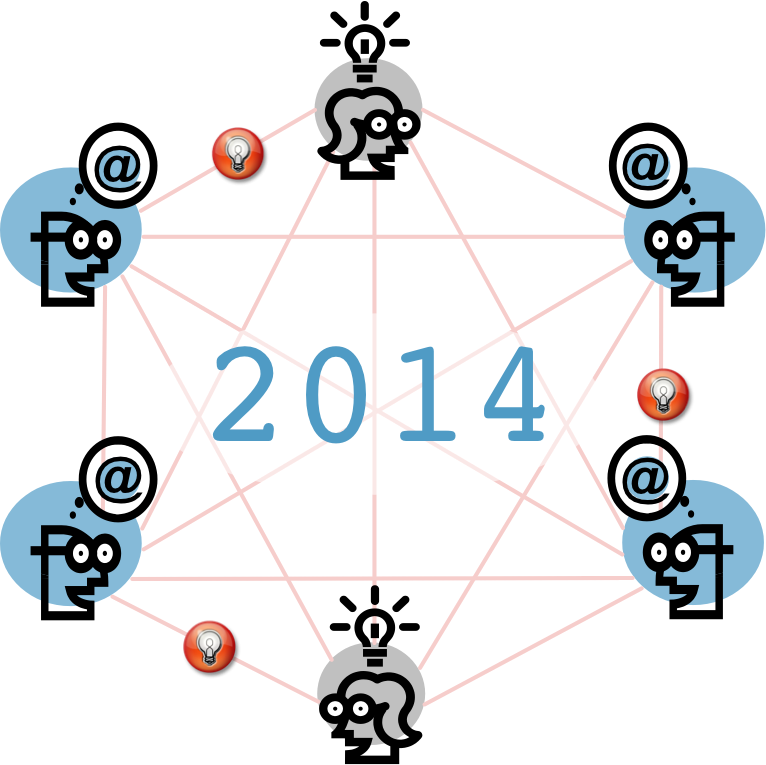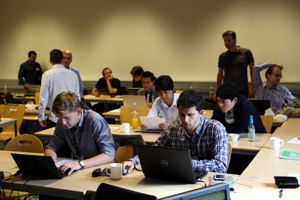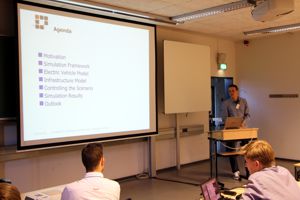OMNeT++ Community Summit 2014
Successor of the International Workshop on OMNeT++
Hamburg, Germany – September 2nd, 2014
INTRODUCTION
Welcome to the first OMNeT++ Community Summit, which is held at the Hamburg University of Applied Sciences in the center of Hamburg, Northern Germany.
OMNeT++ is a public-source, component-based, modular and open-architecture simulation environment with strong GUI support and an embeddable simulation kernel. It is designed to simulate discrete event systems, but the primary application area is the simulation of communication networks.
After six successful editions of the International Workshop on OMNeT++, we decided to change the workshop format to allow for less costs and more interaction between the participants on-site. The successor of the International Workshop on OMNeT++ is the OMNeT++ Community Summit. The Community Summit provides a forum for discussions on recent developments and novel ideas in the area of network simulation and modeling, with a focus on the OMNeT++ simulation environment.

CALL for PARTICIPATION
The summit brings together developers and researchers to discuss applications and ideas on the important topics of integrating simulation models, coupling different simulation tools and providing more accurate and more efficient modeling approaches.
We invite the submission of 2-page abstracts targeting ongoing and finalized research questions, introducing novel simulation techniques, or addressing questions of accurate and efficient modeling for simulation. Further we encourage proposals for tutorials, coding sessions, discussion panels, etc.
All submissions to the summit should be of interest to the OMNeT++ community. We welcome case-studies that employ OMNeT++ in the evaluation of new systems as well as contributions addressing general questions of simulation using OMNeT++. For model-centric submissions we encourage the author(s) to publicize source code at the time of submission.
All submissions will be checked by the organizers. Individual contributions will be invited to be presented as oral presentations, posters, demos, tutorials or panels, depending on their expected interest for the OMNeT++ community.
Topics of interest include, but are not limited to:
- Design, evaluation, and validation of simulation models
- Comparison with other simulation/emulation tools
- Parallel simulation and simulation control
- Integration of hardware-specific code
- Simulative approaches to performance evaluation
- Cross-layer protocol design methodologies
- Simulation credibility and validation
- Use of discrete event simulation in other domains
- Integration with other simulation tools
- Result interpretation and analysis
- Modeling techniques, incl. stochastic and hybrid modeling
- Simulation in the loop
- Industrial applications
SUBMISSION INSTRUCTIONS
Authors are encouraged to submit their 2-page abstracts describing original, previously unpublished work, not currently under review by another conference or venue, addressing state-of-the-art research and topics as listed. If a submission extends work described in a previous publication of their own, we strongly encourage authors to include a citation to that publication.
Abstracts must be submitted electronically via EasyChair.
Submissions should be prepared in the ACM conference proceedings format, available online.
Submissions that are accepted and presented at the summit will appear in the proceedings. The proceedings will be published as a technical report via arXiv and the OMNeT++ website. Copyrights will remain with the authors. This allows for a publication of revised versions at other venues.
SUMMIT PROGRAM
The OMNeT++ Summit intends to be a lively event with a lot of discussions. Each session consists of talks and demonstrations regarding specific sub-topics, which are limited to 15 minutes each. After these kick-offs, we are going to discuss the broader scope of the topics and simulation with OMNeT++ in general.
The proceedings of the 1st OMNeT++ Community Summit are available through arXiv.org.
Tuesday, 02. September 2014 |
Presentations, breaks, and registration will take place in HAW Hamburg, Berliner Tor 5, Room 2.10. Please follow the OMNeT++ Community Summit signs. |
|
| 09:00 - 09:30 | Registration and Coffee | |
| 09:30 - 10:00 | Welcome Note ⇒ Presentation [Video] |
|
| 10:00 - 12:00 | Session 1 - VEINS & Automotive | |
|
Patrick Wunner, Stefan May, Kristian Trenkel and Sebastian Dengler
Development and Testing of Automotive Ethernet-Networks together in one Tool - OMNeT++ In this paper, the network simulation framework OMNeT++ is used for development and testing of automotive Ethernet-Networks. Therefore OMNeT++ is extended by the INET framework. It is augmented by an implementation of the protocol SOME/IP (-SD) and an connector to the middleware Gamma V. The middleware is used to configure the network by initialization. Additionally data, which is sent over the network, can be changed on the fly. The contribution of this work regards three main aspects: First, the use of OMNeT++ for network development in automotive industry. Second, the employment of an existing simulation model and using it as restbus simulation for Hardware in the Loop (HiL) testing or rapid prototyping. Finally, the implementation of SOME/IP(-SD) into OMNeT++. ⇒ Abstract – Publication [PDF] – Presentation [Video] |
||
|
Keigo Kawahara, Yutaka Matsubara and Hiroaki Takada
A Simulation Environment and Preliminary Evaluation for Automotive CAN-Ethernet AVB Networks Ethernet is being considered as the backbone network protocol for next-generation automotive control networks. In such networks, Controller Area Network (CAN) messages related to automotive control can be sent from a CAN network to other sub-networks via the backbone Ethernet bus and, if the CAN messages have real-time constraints, these have to be guaranteed. This paper presents a simulation environment for CAN--Ethernet Audio Video Bridging (AVB) mixed networks based on OMNeT++. We use Ethernet AVB, which can guarantee network bandwidth, to improve the real-time property of CAN messages through the backbone Ethernet bus. To simulate the networks, we also developed a CAN--Ethernet AVB gateway (GW) model. To verify the efficacy of our model, we measured the latency of CAN messages sent from a CAN bus to an Ethernet AVB node via the backbone Ethernet AVB bus in both bandwidth-guaranteed and best-effort queue scenarios. The results indicate that the latency of Ethernet AVB frames containing CAN messages is minimized and limited by the bandwidth-guaranteed mechanism of Ethernet AVB. ⇒ Abstract – Publication [PDF] |
||
|
Sebastian Schellenberg, Rüdiger Berndt, Reinhard German and David Eckhoff
Evaluating the Electrification of Vehicle Fleets using the Veins Framework The case study discussed in this paper involves a company maintaining a vehicle fleet of one hundred vehicles. In this article we will discuss how we extend and deploy the Veins framework, which couples OMNeT++ and SUMO, to help in the process of electrifying this vehicle fleet, i.e., replacing combustion engine cars with electric vehicles to save money and lower CO2 emissions. ⇒ Abstract – Publication [PDF] – Presentation [Video] |
||
|
Discussion:
Veins and Automotive Communications - next steps and cooperation activities
⇒ Presentation [Video] |
||
| 12:00 - 13:00 | Lunch Break | |
| 13:00 - 14:45 | Session 2 - INET | |
|
Mirko Stoffers, Ralf Bettermann, James Gross and Klaus Wehrle
Enabling Distributed Simulation of OMNeT++ INET Models Parallel and distributed simulation have been extensively researched for a long time. Nevertheless, many simulation models are still executed sequentially. We attribute this to the fact that many of those models are simply not capable of being executed in parallel since they violate particular constraints. In this paper, we analyze the INET model suite, which enables network simulation in OMNeT++, with regard to parallelizability. We uncovered several issues preventing parallel execution of INET models. We analyzed those issues and developed solutions allowing INET models to be run in parallel. A case study shows the feasibility of our approach. Though there are parts of the model suite that we didn't investigate yet and the performance can still be improved, the results show parallelization speedup for most configurations. ⇒ Abstract – Publication [PDF] – Presentation [Video] |
||
|
Michael Kirsche and Matti Schnurbusch
A New IEEE 802.15.4 Simulation Model for OMNeT++ / INET This paper introduces a new IEEE 802.15.4 simulation model for OMNeT++ / INET. 802.15.4 is an important underlying standard for wireless sensor networks and Internet of Things scenarios. The presented implementation is designed to be compatible with OMNeT++ 4.x and INET 2.x and laid-out to be expandable for newer revisions of the 802.15.4 standard. ⇒ Abstract – Publication [PDF] – Presentation [Video] |
||
|
Invited Speaker: Levente Meszaros A Unified, Scalable, and Extensible Physical Layer Design for INET This talk introduces the work on the unification and evolution of the INET and MiXiM physical layers, with special attention to modularity / extensibility, scalable level of detail and exploiting parallel hardware for speed. The rework of the physical layer also tackles long-standing issues such as obstacle modeling and directional antennas. ⇒ Presentation [Video] |
||
| Discussion: INET - next steps and cooperation activities | ||
| 14:45 - 15:00 | Short Coffee Break | |
| 15:00 - 16:00 | Session 3 - MiXiM | |
|
Humberto Escudero Argumanez and Matthias Tschauner
Tactical Communication Systems based on Civil Standards: Modeling in the MiXiM Framework In this paper, new work is presented belonging to an ongoing study, which evaluates civil communication standards as potential candidates for the future military Wide Band Waveforms (WBWFs). After an evaluation process of possible candidates, the selection process showed that the IEEE 802.11n OFDM could be a possible military WBWF candidate, but it should be further investigated first in order to enhance or even replace critical modules. According to this, some critical modules of the physical layer has been further analyzed regarding the susceptibility of the OFDM signal under jammer influences. However, the critical modules of the MAC layer (e.g., probabilistic medium access CSMA/CA) have not been analyzed yet. In fact, prior work only suggests to replace this medium access by the better suited Unified Slot Allocation Protocol - Multiple Access (USAP-MA). In this regard, the present contribution describes the design paradigms of the new MAC layer and explains how the proposed WBWF candidate has been modeled within the MiXiM Framework of the OMNeT++ simulator. ⇒ Abstract – Publication [PDF] – Presentation [Video] |
||
|
Van Thiep Nguyen, Matthieu Gautier and Olivier Berder
Implementation of an Adaptive Energy-efficient MAC Protocol in OMNeT++ / MiXiM In recent years, many MAC protocols for wireless sensor networks have been proposed and most of them are evaluated using Matlab simulator and/or network simulators (OMNeT++, NS2, etc). However, most of them have a static behavior and few network simulations are available for adaptive protocols. Specially, in OMNeT++/MiXiM, there are few energy-efficient MAC protocols for WSNs (B-MAC and L-MAC) and no adaptive ones. To this end, the TAD-MAC (Traffic Aware Dynamic MAC) protocol has been simulated in OMNeT++ with the MiXiM framework and implementation details are given in this paper. The simulation results have been used to evaluate the performance of TAD-MAC through comparisons with B-MAC and L-MAC protocols. ⇒ Abstract – Publication [PDF] |
||
| Discussion: MiXiM - next steps and cooperation activities | ||
| 16:00 - 16:30 | Coffee / Snack Break | |
| 16:30 - 17:15 | Session 4 - WSN & Routing | |
|
Michael Frey and Mesut Günes
Attack of the Ants: Studying Ant Routing Algorithms in Simulation and Wireless Testbeds Wireless networks are becoming the key building block of our communications infrastructure. Examples range from cellular networks to ad hoc and sensor networks in wildlife monitoring and environmental scenarios. With the rise of the Internet of Things (IoT) millions of physical and virtual objects will communicate wireless and enhance the daily life. The adaptivity and scalability of wireless networks in the IoT is one of the most challenging tasks. Bio-inspired networking algorithms are a way to tackle these issues. In this paper we present a simulation framework based on OMNeT++ to implement ant routing algorithms to study and compare them on the algorithmic level and an approach to run large simulation studies in a comprehensive way. ⇒ Abstract – Publication [PDF] |
||
|
Gabriel Martins Dias, Boris Bellalta and Simon Oechsner
Towards Information-Centric WSN Simulations In pursuance of integrating Wireless Sensor Networks (WSNs) with other systems, the use of techniques from other fields, such as machine learning and information processing, are becoming more common. Therefore, we faced the problem of missing network simulations that are not only focused on the packet exchange between network elements, but also in the data that is transmitted between them. In other words, we needed a tool that evaluated the WSNs on how they evolve and react to the environmental changes. To illustrate the benefits of having such perspective, we explain the kind of simulation problems that we solved in our last work. Moreover, we outline the next steps in the direction of creating an extension to support this approach. ⇒ Abstract – Publication [PDF] |
||
| 17:15 - 18:30 | Session 5 - OMNeT and Simulation in General | |
|
Invited Speaker: Andras Varga
A Canvas API for OMNeT++ The talk introduces a 2D graphics API that opens up a multitude of possibilities for better visualization in OMNeT++ simulations. ⇒ Presentation [Video] |
||
|
Discussion:
OMNeT - Simulation as a science
⇒ Presentation [Video] |
||
| 19:00 | Meeting for boat tour to the dinner location. Detailed directions will be provided on-site. | |
| 20:30 - open end |
Discussion and Dinner at Dübelsbrücker Kajüt | |
| Location: Dübelsbrücker Kajüt, Elbchaussee 303, 22605 Hamburg | ||
IMPRESSIONS
With over 40 on-site and several remote participants, the first OMNeT++ Community Summit was a huge success. We would like to express our gratitude to all people involved in organizing the event and to all participants.
Below you find links to pictures and videos from the events. If you would like to share your impressions, please contact Michael Kirsche.
SUMMIT VENUE
The 1st OMNeT++ Community Summit will take place at the Hamburg University of Applied Sciences (HAW) in the center of Hamburg city.
On-Site Location:
HAW Hamburg, Campus Berliner Tor
Berliner Tor 5, Room 2.10 > > > Campus Map
(look out for OMNeT++ Community Summit signs directing you to the room)
Accommodation Information
Hotels next to the campus:
Hotels in walking distance:
Suite Novotel
Luebeckertordamm 2
20099 Hamburg
~119 € per night
Motel One Hamburg Alster
Steindamm 102
20099 Hamburg
~69 € per night
Hotel Astoria Hamburg City
Brennerstraße 17
20099 Hamburg
~50 € per night
Hotel Oase
Steindamm 79
20099 Hamburg
~49 € per night
There are several other hotels in the area. Use your favorite booking platform with this address: Berliner Tor 5, 20099 Hamburg, Germany
Hostels:
There are also Hostels around the venue:
Hamburg City Information
With more than 1.8 million people, the Free and Hanseatic City of Hamburg is the second largest city in Germany. The port of Hamburg is the second largest port in Europe.
Hamburg's many streams, rivers and canals are crossed by over 2300 bridges, more than London, Amsterdam and Venice put together. Hamburg has more bridges inside its city limits than any other city in the world and more canals than Amsterdam and Venice combined.
The city is a major tourist destination for both domestic and overseas visitors; it was ranked 10th in the world for liveability in 2010.
The average temperature in September is around 18°C.
Major tourist attractions:
If you would like to spend some additional days in Hamburg, you could visit the following sights:
- Hamburg Harbour
- The new quarter HafenCity and the Speicherstadt
- Museum-Ships Rickmer-Rickmers and Cap San Diego
- The lake Alster
- Cityhall
- Reeperbahn
- Miniatur Wunderland Hamburg (largest model railway in the world)
- ... and many more ...
Travel Information
If you plan to arrive by plane:
- Reach the airport of Hamburg (IATA code: HAM). The airport is very well connected.
- From the airport (both Terminals), the city train (S1) takes you in about 20 minutes to the center of Hamburg. A single trip costs 3 €.
- To reach the venue exit at the station Berliner Tor.
- From the station Berliner Tor the venue is within walking distance.
If you plan to arrive by train:
- Reach Hamburg central station (Hamburg Hauptbahnhof). Hamburg is well connected with the high speed train (ICE) network of Germany.
- The walking distance from the central station is approx. 20 minutes.
- Alternatively you can take the subway train (U1, direction Ohlstedt/Großhansdorf) and exit at the next stop (Lohmuehlenstraße).
- From the station Berliner Tor the venue is within walking distance.
If you plan to arrive by car:
- Reach Hamburg University of Applied Sciences (Address: Berliner Tor 5, 20099 Hamburg, Germany).
- Parking space is limited in this area, there is a subterranean garage on the campus (ca. 10 € per day).
ORGANIZERS
Founding Chair
- Andras Varga (Simulcraft Inc.)
Community Summit Organizers
- Matthias Wählisch (Freie Universität Berlin, Germany)
- Till Steinbach (HAW Hamburg, Germany)
Technical Program Organizers
- Anna Förster (Networking Lab/SUPSI, Switzerland)
- Christoph Sommer (University of Paderborn, Germany)
Publicity Organizers
- Kyeong Soo (Joseph) Kim (Xi'an Jiaotong-Liverpool University, China)
- Michael Kirsche (Brandenburg University of Technlogy, Germany)
In case you want to contact the organizers, feel free to write an e-mail to [email protected].
Sponsors
The OMNeT++ Community Summit 2014 is sponsored. We would like to thank the following sponsors for their support.







